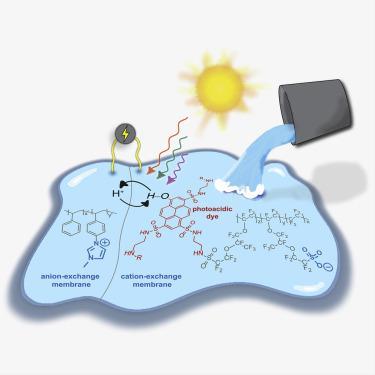Joule ( IF 38.6 ) Pub Date : 2021-07-21 , DOI: 10.1016/j.joule.2021.06.016 Leanna Schulte 1 , William White 1 , Lawrence A. Renna 1 , Shane Ardo 1, 2, 3

|
The key advance that led to the digital revolution was the invention of the solid-state diode, due to its ability to effectively rectify electronic current. Analogous, water-based diodes were invented around the same time, yet their ability to rectify protonic current paled in comparison. A suitable platform to fabricate water-based diodes is the bipolar ion-exchange membrane, which serves as a scaffold for dopants that ionize when infiltrated with protonically semiconducting water. Herein, by fashioning bipolar membranes into membrane-electrode assemblies and characterizing them like fuel cells, we report high-quality protonic diodes that, when sensitized to visible light using photoacids, exhibit “reverse” photovoltaic action. These demonstrations will spur innovations in the fields of iontronics, neuromorphic computing, and brain-machine interfaces, among others.
中文翻译:

通过掺杂和染料敏化将水变成质子二极管和太阳能电池
导致数字革命的关键进步是固态二极管的发明,因为它能够有效地整流电子电流。类似的水基二极管大约在同一时间发明,但相比之下,它们整流质子电流的能力相形见绌。制造水基二极管的合适平台是双极离子交换膜,它充当掺杂剂的支架,掺杂剂在被质子半导体水渗透时会发生电离。在此,通过将双极膜制成膜电极组件并将其表征为燃料电池,我们报告了高质量的质子二极管,当使用光酸对可见光敏感时,表现出“反向”光伏作用。这些演示将刺激离子电子学、神经形态计算、











































 京公网安备 11010802027423号
京公网安备 11010802027423号